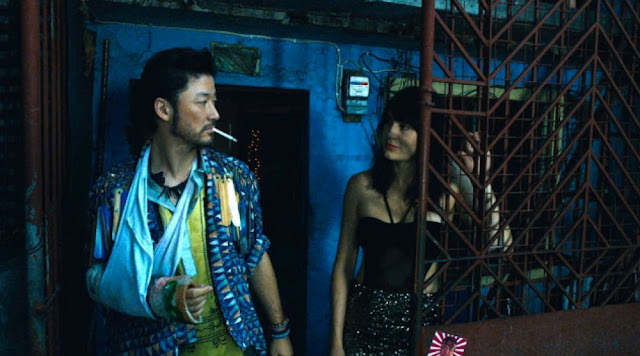PUSONG WAZAK (Khavn Dela Cruz, 2015)
* International English title: "Ruined Heart"
You've seen this film already, Khavn says during the Philippine premiere of his latest feature. The tagline even reads "another love story between a criminal and a whore," yet Khavn's take on one of the most known (and heavily overused) cinematic sub genres is anything but ordinary.
Japanese actor Tadanobu Asano (Ichi the Killer) is the "criminal," in love with Mexican actress Nathalia Acevedo (Post Tenebras Lux) who plays the "whore." They cannot go public with their affections for one another lest incurring the wrath of the "godfather," played by Vim Nadera.
Meanwhile, Russian-German actress Elena Kazan is the "lover," whose undying love is pivotal in the film's later part, while Andre Puertollano is the "friend," who in one scene defends the "criminal" against an army of thugs, using his skills in Muay Thai (Puertollano teaches Muay Thai at Ateneo in real life).
The film has no dialogue, and doesn't need it because the music and images already create an immersive experience, as if an opera that haunts your senses.
Partly shot by Hong Kong-based Australian cinematographer Christopher Doyle, "Ruined Heart" benefits from breathtaking framing and sensual lighting that have come to be associated with the man. One particular scene where Asano and Acevedo escape through a labyrinth of narrow alleys vividly echo a similar fast-paced sequence from Wong Kar-wai's "Chungking Express," which Doyle also shot. Meanwhile, Carlo Manatad's editing made jump cuts exciting again, ever since Godard made it cool via his 1960 gangster film "Breathless."
Music is 50% of "Pusong Wazak," and the soundtrack, comprising French pop, rock and kundiman, among others propels the film into a bizarre psychedelic adventure. The "Ruined Heart" end credits theme is the cherry on top, a mirror of the characters' gung ho attitude, capping a journey best described as the marriage of giddy and melancholy.
Khavn himself appears in the film as a pianist, whose enigma complements the overall weirdness of the world he created.
Indeed, the story of "Pusong Wazak" have been told and retold many times before, yet the film's beauty comes from Khavn's unflinching commitment to push boundaries, to challenge viewers' traditional concept of cinema. The film is significantly easier to digest than his previous "Mondomanila," or even the genre-pushing "Squatterpunk," and while some viewers will be questioning the logic or backstories of some the scenes in "Pusong Wazak," it is arguably Khavn's most polished, most perfect film to date. The politics still exists, but "Pusong Wazak" is more of a love letter to cinema than a platform for social dynamics.
RATING: 5/5




Comments
Post a Comment